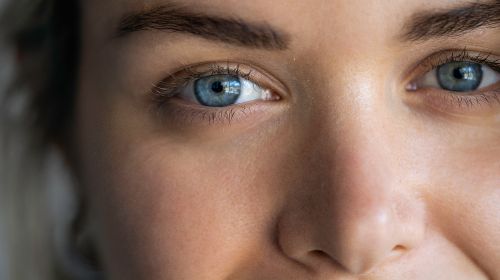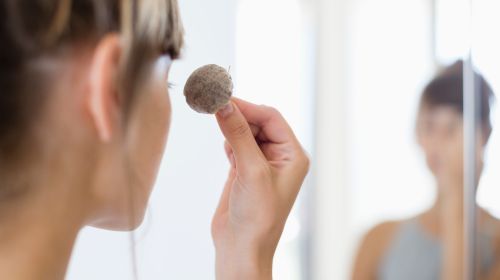Symptoms of eyelid inflammation include sticky, crusty, red and swollen eyelids. If left untreated, the symptoms can persist. Where the inflammation comes from and what helps against blepharitis.
- © oes – stock.adobe.com
Quick overview
Definition: In the case of eyelid inflammation (blepharitis), the inner skin directly on the eye, the so-called eyelid edge, is inflamed. Blepharitis usually occurs in both eyes but is not contagious.
Home remedies: Eyebright contains anti-inflammatory substances and can help with eyelid inflammation.
Therapy: Consistent daily eyelid hygiene; in the case of bacterial infections, antibiotic eye drops or ointments can be prescribed.
Causes: A variety of triggers, from blocked sebaceous glands on the edge of the eyelids to bacterial infections and irritation from dust or smoke.
Article contents at a glance:
What is eyelid inflammation?
The term blepharitis covers various forms of inflammation of the eyelids that have similar symptoms and require the same treatment. The underlying cause is almost always a disturbed production of the eye glands.
There are tiny sebaceous glands (meibomian glands) on the eyelids that form a protective, oily tear film on the surface of the eye. This is important so that the tears do not dry out so quickly. If there is excessive sebum production, the meibomian glands can become blocked and inflamed.
Forms of eyelid inflammation
Inflammation of the eyelid margin can manifest itself in different ways and in different places:
Blepharitis squamosa: with dry scales on the edge of the eyelashes
Ulcerative blepharitis: inflamed, swollen and crusty eyelid edges
Angular blepharitis: only the corner of the eye is affected
Hordeolum (barleycorn): inflammatory abscess of the eyelid glands. A stye is usually painful, but not dangerous and often disappears on its own.
Chalazion (hailstone): Encapsulation of the meibomian glands. A hailstone is usually not painful, but must be treated because of the risk of subsequent damage to the eye.
Relieve eyelid inflammation with home remedies?
In principle, eyelid inflammation belongs in the hands of professionals. A plant infusion made from eyebright (Euphrasia) can be used as a supportive treatment for eyelid inflammation. The local plant contains antibacterial and anti-inflammatory substances and has proven useful for eye diseases.
A diet rich in omega-3 fatty acids also supports the regeneration of the meibomian glands and the sensitive eyelid skin. The healthy fatty acids are found, for example, in fatty sea fish, linseeds, linseed oil and walnuts.
It is often recommended to rinse the eyes with chamomile solution or to place compresses made from chamomile tea bags on the eyelids. chamomile However, it should not be used because of a possible allergy-triggering effect on the eyes. Those affected should also avoid using a saline solution or vinegar rinse. Such home remedies may cause further damage to the eye.
Therapy for eyelid inflammation
If blepharitis has been diagnosed by a doctor, careful eyelid hygiene consisting of heat application, eyelid cleaning and eyelid massage is recommended. Daily eye care is considered the most important pillar in the successful treatment of eyelid inflammation. Heat supports healing and makes it easier to remove the crusts and clean the edge of the eyelid.
Eyelid hygiene steps:
1. Heat application: Place moist, warm cotton pads, a clean cloth or a washcloth as a compress on your closed eyes for about five to ten minutes. This liquefies the thick, sebaceous secretion that clogs the glands and makes it easier to remove. A heat gel mask, thermal goggles or red light lamp are also helpful.
2. Gentle eyelid massage: Using a clean finger or cotton swab, gently stroke several times from the outside towards the eyelashes, from top to bottom from the upper eyelid towards the eyelash line and vice versa upwards from the lower eyelid. In this way, excess secretions can be removed from the glands.
3. Eyelid edge cleaning: Clean the eyelids with a damp cotton pad and carefully remove the loosened secretions and deposits on the edge of the eyelids. A surfactant-free lotion from the drugstore or pharmacy is best suited for this, as the viscous sebum is poorly soluble in water.
4. Humidification: Until the tear film in the eye has normalized, it is helpful to alleviate the feeling of dryness with artificial tears or lubricating eye drops. These can be used several times a day to hourly as needed.
Eyelid edge care must be used long-term in order to be successful. In the first few weeks of treatment, you should avoid contact lenses and cosmetics on your eyes if possible.
If the ophthalmologist has diagnosed a bacterial infection, those affected will be prescribed antibiotic eye drops or ointments.
Typical symptoms of blepharitis
Anyone suffering from the following symptoms could have eyelid inflammation:
- thickened, swollen eyelid edges
- Redness of the eyelids
- itching
- crusty, flaky or barky deposits
- White-grey, greasy deposits on the edge of the eyelids and eyelashes
- Foreign body sensation in the eye
- dry eyes (Sicca syndrome)
- tired, watery, burning eyes
- Eye pain
- Eyelash loss (madarosis)
- Visual fluctuations
- Sensitivity to light
In many cases, the symptoms are strongest when you wake up in the morning: the eyes are crusty and sticky, the edges of the eyelids are red and inflamed, and the eyelids are swollen. The symptoms often improve over the course of the day, but they never completely disappear. If left untreated, they usually worsen over time.
Eyelid inflammation or conjunctivitis: what’s the difference?
Distinguishing eyelid inflammation from conjunctivitis is not so easy. The symptoms for both are itchy, sore eyes. However, in conjunctivitis the conjunctiva covering the eyeball is red, while in blepharitis only the eyelids are affected.
Conjunctivitis is a very common, acute infection that usually resolves quickly with proper treatment. Eyelid inflammation, on the other hand, is lengthy. It can happen that the conjunctiva is also affected in acute blepharitis, which is then referred to as blepharoconjunctivitis.
Most common causes of eyelid inflammation
There are numerous factors that can disrupt the delicate balance in the eye and lead to eyelid inflammation.
Depending on the trigger, experts differentiate between:
scaly eyelid inflammation: Dry scaling at the base of the eyelashes, caused by congenital oversecretion of the eyelid glands (meibomian gland dysfunction).
infectious eyelid inflammation: Accumulates Secretion on the edge of the eyelid can cause bacteria or other pathogens to settle there. In most cases it is staphylococci that cause the inflammation. Viruses are also possible, for example herpes simplex, and rarely mites, ticks or pubic lice.
Allergic eyelid inflammation: An allergic reaction to care products or cosmetics (e.g. mascara), medications such as eye drops or eye ointment is common. The body can also react to allergens such as pollen or dust mites. Typical of allergic blepharitis is a balloon-like swelling that extends over the entire eyelid (lid oedema).
Other causes of inflamed eyelid edges:
Environmental factors can dry out or irritate the eyes, for example dust, wind, smoke, air conditioning or dry heating air.
Hormonal changes are possible triggers. Women during and after menopause often experience dry eyes and inflammation of the eyelids due to hormonal changes.
Systemic diseases are sometimes involved in the development of blepharitis. Metabolic diseases such as diabetes mellitus, rheumatism or thyroid diseases affect the function of the glands in the body. Skin diseases such as rosacea, acne, neurodermatitis and seborrheic dermatitis (seborrhea) are also possible triggers.
Diagnosis of eyelid inflammation – sometimes not so easy
To diagnose eyelid inflammation, the ophthalmologist will take a swab from the edge of the eyelid. In this way, colonization with bacteria or other pathogens can be detected. Furthermore, a systemic disease such as diabetes mellitus must be ruled out. Therefore, in the case of chronic blepharitis, a detailed examination including a complete blood count is advisable.
Good prognosis with consistent eye hygiene
Chronic blepharitis is usually not dangerous and some people live with it for years without feeling particularly affected by it. Over time, however, it can lead to secondary diseases that can affect the eyesight in the long term. Common complications include styes and hailstones.
Blepharitis should therefore be treated consistently. However, with regular eyelid care, the prognosis is good. However, those affected must be patient. It takes around three to four weeks for the skin on the edge of the eyelid to regenerate.



